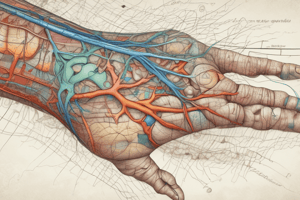Podcast
Questions and Answers
Which dermatome is primarily responsible for sensory perception on the medial malleolus?
Which dermatome is primarily responsible for sensory perception on the medial malleolus?
- L4 (correct)
- L3
- S1
- L5
What is the key sensory distribution area for the femoral nerve?
What is the key sensory distribution area for the femoral nerve?
- Lateral foot
- Medial ankle
- Anterior thigh (correct)
- Posterior thigh
Which nerve contributes to the sensory innervation of the plantar surface of the foot?
Which nerve contributes to the sensory innervation of the plantar surface of the foot?
- Sural nerve
- Lateral cutaneous nerve
- Medial plantar nerve (correct)
- Deep fibular nerve
Where is the primary sensory area for the lateral foot found?
Where is the primary sensory area for the lateral foot found?
Which nerve is responsible for the sensory innervation of the medial leg?
Which nerve is responsible for the sensory innervation of the medial leg?
What is a dermatome?
What is a dermatome?
Which spinal nerve root corresponds to the anterior portion of the thigh?
Which spinal nerve root corresponds to the anterior portion of the thigh?
Why are there two different diagrams of dermatomes?
Why are there two different diagrams of dermatomes?
In terms of innervation, what is the role of the lumbosacral plexus in the lower extremity?
In terms of innervation, what is the role of the lumbosacral plexus in the lower extremity?
What does the ASIA map help to remember regarding dermatomes?
What does the ASIA map help to remember regarding dermatomes?
Which of the following statements accurately describes the function of the gluteal nerves?
Which of the following statements accurately describes the function of the gluteal nerves?
Which nerve roots are associated with the lumbar plexus?
Which nerve roots are associated with the lumbar plexus?
What is the significance of the lumbosacral trunk?
What is the significance of the lumbosacral trunk?
Which of the following nerves is NOT part of the lumbar plexus?
Which of the following nerves is NOT part of the lumbar plexus?
What does the term 'common' imply in anatomical terminology?
What does the term 'common' imply in anatomical terminology?
What is the primary function of the obturator nerve?
What is the primary function of the obturator nerve?
What happens if the femoral nerve is damaged?
What happens if the femoral nerve is damaged?
Which statement about the femoral nerve is true?
Which statement about the femoral nerve is true?
Which muscles are primarily affected by the femoral nerve?
Which muscles are primarily affected by the femoral nerve?
What is the sensory function of the lateral femoral cutaneous nerve?
What is the sensory function of the lateral femoral cutaneous nerve?
Where do all the nerves from the lumbar plexus typically emerge from?
Where do all the nerves from the lumbar plexus typically emerge from?
Which nerve runs medial to the psoas muscle?
Which nerve runs medial to the psoas muscle?
Which of the following nerves provides sensory input to the superolateral portion of the thigh?
Which of the following nerves provides sensory input to the superolateral portion of the thigh?
Which major nerve of the lumbar plexus passes under the inguinal ligament into the anterior thigh?
Which major nerve of the lumbar plexus passes under the inguinal ligament into the anterior thigh?
What spinal nerve root levels contribute to the femoral nerve?
What spinal nerve root levels contribute to the femoral nerve?
Flashcards are hidden until you start studying
Study Notes
Lumbosacral Plexus Overview
- The lumbosacral plexus is a network of nerves that innervates the lower extremity.
- It is formed by the ventral rami of spinal nerves L1-L4 (lumbar plexus) and L4-S4 (sacral plexus).
- Major nerves of the lumbar plexus: Lateral cutaneous nerve of the thigh, femoral nerve, obturator nerve.
- Major nerves of the sacral plexus: Nerve to quadratus femoris, nerve to obturator internus, nerve to piriformis, superior gluteal nerve, inferior gluteal nerve, posterior femoral cutaneous nerve, tibial nerve, common fibular nerve.
- The sciatic nerve is the largest nerve in the body and is formed by the tibial and common fibular nerves.
Lumbar Plexus in Detail
- The lumbar plexus is formed within and around the psoas major muscle.
- Lateral cutaneous nerve of the thigh: Emerges from the lumbar plexus lateral to the psoas muscle and runs towards the ASIS, providing sensory innervation to the lateral thigh.
- Femoral nerve: Largest nerve of the lumbar plexus, emerges lateral to the psoas muscle, runs under the inguinal ligament, and provides motor and sensory innervation to the anterior thigh, knee, and leg.
- Obturator nerve: Emerges medially from the psoas muscle, runs through the obturator foramen, and provides motor and sensory innervation to the medial thigh.
- Nerve root contributions to lumbar plexus nerves:
- Lateral cutaneous nerve of the thigh: L2, L3
- Femoral nerve: L2-L4
- Obturator nerve: L2-L4
Clinical Relevance
- The proximity of the lumbar plexus to the psoas muscle highlights the importance of considering psoas muscle tension or impingement as a potential source of nerve-related issues.
- Learning the nerve root contributions and sensory distributions of the nerves in the lumbar plexus helps to pinpoint the source of pain, numbness, or weakness in the lower extremity.
Femoral Nerve
- The femoral nerve innervates the anterior compartment of the thigh
- It innervates the quadriceps, which is responsible for knee extension
- It also contributes to hip flexion through its innervation of iliacus, rectus femoris, sartorius, and pectineus
- Damage to the femoral nerve would result in difficulty with hip flexion and complete inability to extend the knee
- The femoral nerve runs deep to the inguinal ligament
- It emerges into the thigh in the femoral triangle
- The femoral nerve passes anterior to the hip joint, thus hip extension would increase tension on this nerve
- The femoral nerve passes slightly anterior to the knee, so knee flexion may also cause tension on the nerve
Obturator Nerve
- The obturator nerve shares the same nerve roots as the femoral nerve and overlaps with similar dermatomes
- The obturator nerve innervates all of the muscles in the medial compartment of the thigh, which are the adductors
- It also provides innervation to the hip joint and the medial thigh
- Abduction of the hip or thigh could lead to increased tension on the obturator nerve
Lumbar Plexus
- The lateral femoral cutaneous nerve emerges from psoas, heads towards the ASIS, and pierces the fascia lata of the thigh
- The lateral femoral cutaneous nerve gives sensory innervation to the lateral thigh
- The lumbar plexus gives rise to the femoral, obturator, and lateral femoral cutaneous nerves
Sacral Plexus
- The sacral plexus is responsible for innervating the muscles of the gluteal region and the posterior thigh
- It also innervates the posterior leg and plantar foot
- Almost all nerves of the sacral plexus, most notably the sciatic nerve, emerge from the greater sciatic foramen just inferior to piriformis
- The sciatic nerve is susceptible to impingement by piriformis
Sciatic Nerve
- The sciatic nerve emerges from the greater sciatic foramen just deep to piriformis
- It runs through the gluteal region, and posterior thigh, diving into the popliteal fossa at the back of the knee
- The sciatic nerve splits into the tibial and common fibular nerves at the popliteal fossa
- The sciatic nerve may be restricted due to excessive tension or scarring around the piriformis muscle
- Hip flexion will tension the sciatic nerve
Tibial Nerve
- The tibial nerve, one of the main branches of the sciatic nerve, is responsible for innervating the posterior thigh, leg, and plantar foot
- It innervates the hamstring muscles
- It innervates muscles in the posterior compartment of the leg, including gastrocnemius and soleus
- It continues into the plantar foot
- The tibial nerve runs inferiorly directly through the midline of the popliteal fossa
- It dives between the 2 heads of gastrocnemius and passes deep to soleus
- The tibial nerve runs along the medial malleolus and passes into the plantar surface of the foot
- The tibial nerve splits into the medial and lateral plantar nerves that innervate the plantar foot
- Hip flexion will tension the tibial nerve
Common Fibular Nerve
- The common fibular nerve, the second branch of the sciatic nerve, is responsible for innervating the short head of biceps femoris
- It splits into the superficial and deep fibular nerves
- The deep fibular nerve innervates the anterior compartment of the leg, supplying muscles like dorsiflexors and long toe extensors
- The superficial branch of the fibular nerve innervates the lateral compartment of the leg, supplying the fibularis muscles, primarily the evertors
- It wraps around the lateral aspect of the knee
- The common fibular nerve runs inferiorly to the knee
Other Sacral Plexus Nerves
- The superior and inferior gluteal nerves, nerve to quadratus femoris, nerve to obturator internus all innervate the smaller gluteal muscles
- The posterior femoral cutaneous nerve supplies cutaneous sensation to the buttock and posterior thigh
- The internal pudendal nerve innervates the perineum and provides sensation to that region
- The pudendal nerve innervates small muscles in the genital region
- The nerve to levator ani comes off the sacral plexus, and as its name says, goes to the pelvic floor
Other Important Information
-
The lumbar plexus is involved in innervation of the lower limb, while the sacral plexus is responsible for innervation of the pelvic region
-
The sciatic nerve is the longest nerve in the body
-
The obturator nerve is responsible for adduction of the thigh
-
The superior and inferior gluteal nerves innervate the gluteal muscles
-
The posterior femoral cutaneous nerve innervates the skin over the glutes and posterior thigh
-
The internal pudendal nerve innervates the perineum and provides sensation to that region ### Lumbosacral Plexus Sensory Distributions
-
Lateral Cutaneous Nerve of the Thigh: Innervates the proximal lateral thigh, wrapping from anterior to posterior.
-
Obturator Nerve: Innervates the medial thigh, wrapping from anterior to posterior.
-
Femoral Nerve: Innervates the anterior thigh.
-
Saphenous Nerve: Innervates a large portion of the medial leg, extending from the femoral nerve.
-
Posterior Femoral Cutaneous Nerve: Innervates a large portion of the posterior thigh, as its name suggests.
-
Sural Nerve: Innervates the lateral and posterior area of the leg, with variation in some individuals.
-
Fibular Nerve: Covers the top of the foot with its superficial branch.
-
Tibial Nerve: Innervates the plantar foot with its lateral and medial branches.
Anterior Hip Sensory Innervation
- Nerves like the genitofemoral, ilioinguinal, and iliohypogastric provide sensation to the hip crease and genitals.
Clunial Sensory Innervation
- The clunial nerves, superior, middle, and inferior, provide sensation to the buttocks or clunial region.
- These nerves are branches of the posterior rami of the lumbar and sacral nerve roots.
Dermatome Distribution
- The femoral nerve distribution overlaps with L2, L3, and L4 dermatomes.
- The L5 dermatome runs down the lateral leg to the dorsum of the foot, corresponding to the sural, superficial, and deep fibular nerves which have L5 contributions.
- The plantar foot is innervated by the tibial nerve, which carries S1 and L5 nerve roots.
Clinical Implications
- Numbness or tingling in the lower extremity can point to sensory involvement of a peripheral nerve or a nerve root.
- Understanding dermatome and sensory distributions is crucial for differential diagnosis, distinguishing between peripheral nerve and nerve root involvement.
Studying That Suits You
Use AI to generate personalized quizzes and flashcards to suit your learning preferences.




